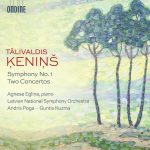

Composer: Tālivaldis Ķeniņš
Performer: Iveta Apkalna
Orchestra: Latvian National Symphony Orchestra
Conductor: Andris Poga
Format: FLAC (tracks)
Label: Ondine
Catalogue: ODE 1388-2
Release: 2022
Size: 922 MB
Recovery: +3%
Scan: yes
Symphony No. 5
01. I. Molto animato
02. II. Doppio lento
03. III. Largo espressivo
04. IV. Vivace e con fuoco
Symphony No. 8 for Organ & Orchestra “Sinfonia concertata”
05. I. Moderato
06. II. Chorale. Largo
07. III. Toccata
08. Aria per corde
This third album release in the first complete Tālivaldis Ķeniņš (1919–2008) symphony cycle includes the composer’s final symphonic creation, Symphony No. 8, with a remarkable organ solo part performed by Iveta Apkalna, alongside the composer’s dramatic and concise 5th Symphony, both conducted by Andris Poga and performed by the Latvian National Symphony Orchestra.
Tālivaldis Ķeniņš (1919–2008), one of Latvia’s most prominent composers, wrote an impressive cycle of eight numbered symphonies. Although born in Latvia, Ķeniņš lived most of his life as an exile. He was educated in Paris, where he studied under Tony Aubin and Olivier Messiaen, and won several awards. Ķeniņš emigrated to Canada in 1951 and became a respected pedagogue and a very influential figure in Canada’s music life. Especially the 1970s and the 1980s were fruitful years to Ķeniņš as a symphonist: both Ķeniņš’ 5th and 8th Symphonies were premiered in Toronto, the previous in 1976 and the latter in 1986.
Ķeniņš’ 5th Symphony starts with a powerful orchestral climax and it is a work with dark undercurrents. However, here the composer balances with two different opposite materials: the robust, contemporary world meets a fairy tale landscape glittering with the magic of dusk in the Latvian countryside. The Symphony No. 8 lends itself to analysis but not to description. In this work, Ķeniņš has quite possibly attained his highest metaphysical peak. From the storms of the first part and some longed for unattainability, through the second part’s luminous chorale to the finale of the third part with its eight double and triple beats, concluding with a single beat and transcendence. This symphony-concerto for organ and orchestra calls for a combination of masterful solo organ skills. In addition to excellent technique and a deep understanding of complex forms, a fine sense of the organ’s registers is also required, so that the organ part can both blend and shine in a surprising balance of musical pattern and orchestral instrumentation.



